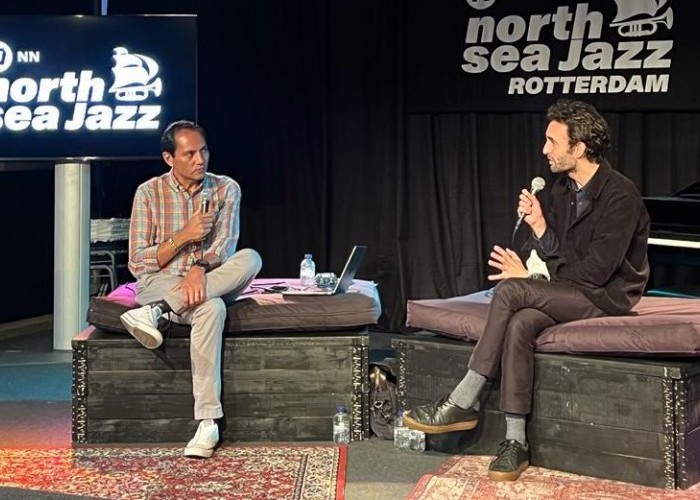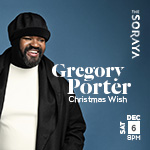Oct 28, 2025 10:47 AM
In Memoriam: Jack DeJohnette, 1942–2025
Jack DeJohnette, a bold and resourceful drummer and NEA Jazz Master who forged a unique vocabulary on the kit over his…

Julian Lage, right, joined writer Nate Chinen for a live Blindfold Test at the North Sea Jazz Festival.
(Photo: Dries Verbeeck)When Julian Lage sat down for this live Blindfold Test at the North Sea Jazz Festival last July, the guitarist/composer was in the throes of a summer-long tour and preparing to launch his latest, well-received recording, View With A Room (Blue Note). As always, no hints were given beforehand, and the test was delivered by noted author Nate Chinen, who serves as editorial director for WRTI, a non-commercial public radio station serving greater Philadelphia from Temple University. This was Lage’s first Blindfold Test.
Charlie Christian
“Flying Home” (The Radio Broadcasts 1939–1941, Stardust/Cleopatra, 2001) Christian, guitar; Benny Goodman, clarinet; Lionel Hampton, vibes; Fletcher Henderson, piano; Artie Bernstein, bass; Nick Fatool, drums.
I would venture to say that’s Mr. Charlie Christian. It’s with Benny Goodman, and is it Red Norvo? Ah, Lionel Hampton. I would think late ’30s or early ’40s. Those are very interesting years, especially in the evolution of the guitar. It changed rapidly. From the beginning of the ’30s to the end of the ’30s, it was a revolution. Going from basically banjo being the closest thing in a jazz band to being a full-fledged, lyrical, narrative-driven soloing kind of instrument. Charlie Christian’s the greatest ever, in my opinion. What’s so beautiful about this example is not only do we hear his phrasing, which is iconoclastic, and I wish I could do that — but you also hear his accompaniment, which isn’t as well documented on the records with Benny Goodman. You hear how rhythmically interactive he is. It’s just stunning. … How many stars? All of ’em.
Lenny Breaux
“Don’t Think Twice, It’s Alright” (Guitar Sounds From Lenny Breau, RCA Victor, 1969) Breaux, guitar; Ronnie Halldorson, bass; Reg Kelln, drums.
At first I thought it was Bola Sete, and it’s not. And then I’m between Charlie Byrd and Lenny Breaux. It must be Charlie.
Chinen: It’s Lenny Breaux. Recorded in 1968. This is from Guitar Sounds From Lenny Breau, which was his debut album. Chet Atkins was at RCA, and he recorded this at RCA studios in Nashville.
Lage: That’s what threw me off. It sounds like an old country record, honestly. Lenny Breaux’s style especially toward the end of his life was so idiosyncratic. And you hear it in the closing chord of that, when he does his famous artificial harmonics. But for the majority of that, it’s just the earlier stages of such a legendary sound. That’s fantastic. The whole concept of a jazz guitarist playing a nylon-string or gut-string guitar is kind of novel, even to this day. … What I loved was how seamlessly he moved from whatever the song is to the improvisation. 5 stars.
Jim Hall
“Skylark” (Magic Meeting, ArtistShare, 2004) Hall, guitar; Scott Colley, bass; Lewis Nash, drums.
[almost immediately] It’s Jim, right? That’s so good. … Jim famously played quiet enough that even if he was using an amplifier, you could still hear the acoustic sound of the guitar. And on that recording they captured it beautifully, where you hear the fingers on the strings, you hear the pick on the string, you hear, you know, the sensuality of it. And it’s blended with this very warm, very cohesive Polytone or Walter Woods amplified sound. That alone is kind of untouchable. No one quite had that together. I would almost make the argument that if you heard Charlie Christian’s acoustic sound with his acoustic sound, it would be similar. Another thing that’s interesting is that for a lot of guitar players, we have six strings, right? We tend to live on the higher ones most of the time and leave the lower ones out, because they can have conflict. For 75 percent of that, Jim’s playing completely in the low part of the guitar where you’re told never to play, because it’s going to get in the way of the bass. It just kind of proves that those are fake rules, and if you’re musical about it, there’s a lot of freedom there for you. So a lot of Jim’s thing is extreme courage. It’s like Picasso: he just did the thing that we all want to do, and he did it better than anybody. 5 stars, without a doubt.
Nels Cline
“The Angel Of Angels” (Draw Breath, Cryptogramophone, 2007) Cline, electric and acoustic guitars; Devin Hoff, bass; Scott Amendola, drums and effects.
It’s beautiful. I don’t know that recording. You know, first I thought of Ralph Towner, but it’s two guitar players, right?
Chinen: It’s overdubbed.
Lage: And is it the guitar player’s record, or the bass player’s record?
Chinen: Guitar player’s.
Lage: And the year?
Chinen: This is 2007.
Lage: It’s not Wolfgang [Muthspiel], is it? Well, who is it? I love it. [afterwards] Man, I thought of Nels! I know that album, too. Oh, it’s so good! I should have known because there’s no solo that it was Nels. That’s a very Nels Cline thing to do.
Chinen: This occurred to me not only because you and Nels have this relationship, but also because this composition felt like it’s in your world.
Lage: Absolutely. I’ve been playing with Nels for many, many years now. I’ve been with him when he overdubs guitars. And one of his superpowers is that he can overdub guitars in such a way that you’d never lose sight of the primary instrument. It doesn’t become a sparring match. It’s just orchestration; he’s a really good orchestrator. And I’ve witnessed him do it, and he does it there beautifully.
Mary Halvorson
“Nodding Yellow” (Belladonna, Nonesuch, 2022) Halvorson, guitar.
It’s definitely Mary. Is that the new record on Nonesuch? Absolutely wonderful. Mary’s a dear friend of mine. My old neighbor. And I admire her so much. What’s so striking is, I know her individuality as a guitar player. As an interpreter, as an improviser. And the liberty she has as a composer to translate that vocabulary to these other instruments and still maintain it as an expression of chamber music is just the highest, most inspiring level. And, similar to Jim, her sense of humor is what I always find. You know, it’s not deadly serious. It’s fun and it’s adventurous and it’s risky. It just reminds me of all the things I love in music. … 5 stars. DB
The “Blindfold Test” is a listening test that challenges the featured artist to discuss and identify the music and musicians who performed on selected recordings. The artist is then asked to rate each tune using a 5-star system. No information is given to the artist prior to the test.

Jack DeJohnette boasted a musical resume that was as long as it was fearsome.
Oct 28, 2025 10:47 AM
Jack DeJohnette, a bold and resourceful drummer and NEA Jazz Master who forged a unique vocabulary on the kit over his…

D’Angelo achieved commercial and critical success experimenting with a fusion of jazz, funk, soul, R&B and hip-hop.
Oct 14, 2025 1:47 PM
D’Angelo, a Grammy-winning R&B and neo-soul singer, guitarist and pianist who exerted a profound influence on 21st…

To see the complete list of nominations for the 2026 Grammy Awards, go to grammy.com.
Nov 11, 2025 12:35 PM
The nominations for the 2026 Grammy Awards are in, with plenty to smile about for the worlds of jazz, blues and beyond.…

Jim McNeely’s singular body of work had a profound and lasting influence on many of today’s top jazz composers in the U.S. and in Europe.
Oct 7, 2025 3:40 PM
Pianist Jim McNeely, one of the most distinguished large ensemble jazz composers of his generation, died Sept. 26 at…

Drummond was cherished by generations of mainstream jazz listeners and bandleaders for his authoritative tonal presence, a defining quality of his style most apparent when he played his instrument unamplified.
Nov 4, 2025 11:39 AM
Ray Drummond, a first-call bassist who appeared on hundreds of albums as a sideman for some of the top names in jazz…






